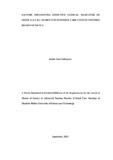FACTORS INFLUENCING EFFECTIVE CLINICAL HAND-OVER OF CRITICALLY ILL PATIENTS IN INTENSIVE CARE UNITS IN WESTERN REGION OF KENYA
Abstract
Handover involves transfer of health care providers’ responsibility and accountability
for some or all aspects of care for a patient, or groups of patients, to another person,
such as a clinician or nurse on a temporary or permanent basis. A health care provider
can take over responsibility for a patient only if he or she receives all relevant
information to facilitate continuation of effective and safe patient care. Handover is
essential for safe health care and is used in all clinical situations. In Western Kenya
there is little evidence of studies carried out on factors of critically ill patients. This
study therefore sought to address the gap. The study was conducted in Moi Teaching
and Referral Hospital, Jaramogi Oginga Odinga Teaching and Referral Hospital,
Mediheal and Aga Khan Hospital in Kisumu. A cross sectional analytical research
design was adopted in conducting the study. Purposive sampling method was used to
select the institutions while convenient sampling was used to pick 80 study
participants. Quantitative data was collected by use of questionnaires and observation
check list and analyzed by descriptive techniques and inferential showing association
between factors and handover. Qualitative data was collected through key informant
interviews and was analyzed thematically. The study results showed that handover
was done at the beginning, admission, discharge and end of shift using both oral and
written. Majority (82.5%) of the participants had been trained on patient handover.
Sixty (60%) thought that patient’s bedside is the most appropriate place for handover
as compared to 37.5% who preferred nursing station, while 2.5% indicated that the
conference room was the most appropriate place for handover. All the interviewed
staff took part in handover process. Majority (91.2%) agreed that alarms were a major
distraction in their unit during handover. This was followed by emergency cases and
noise. Majority (95%) agreed that unstable hemodynamics of patients and severity of
illness (93.8%) greatly influenced handover. Further findings showed that staff who
agreed that visitors and emergency cases affect handover, were up to 8 (p = 0.1) and
7 (p = 0.3) times more likely to have been more effective in their handover
performance. On the contrary health care providers who mentioned that clinical
handover is done at the beginning or the end of shift were 80% less likely to have been
effective in their performance (OR: 0.2; 95% CI: 0.1 – 0.8; p = 0.02). health care
providers who agreed that supplies which include consumables (OR:3.2,95% Cl:1.1-
8.9,p=0.02) availability of clinical handover policy in the unit (OR:3.3;95%Cl:1.1-
9.5;P=0.02) were three times more likely to perform effectively. The study concludes
that health care provider should ensure proper handover is done on critically ill
patients to ensure quality outcomes. Similarly, proper documentation should be
enhanced because heath care provider needs to review handover from this
documentation and confirm that the care was done. The study recommends formal
teaching session in medical training colleges to enhance staff’s competency in
handing over among health care providers. There should be protocols and guidelines
to assist during handover.

